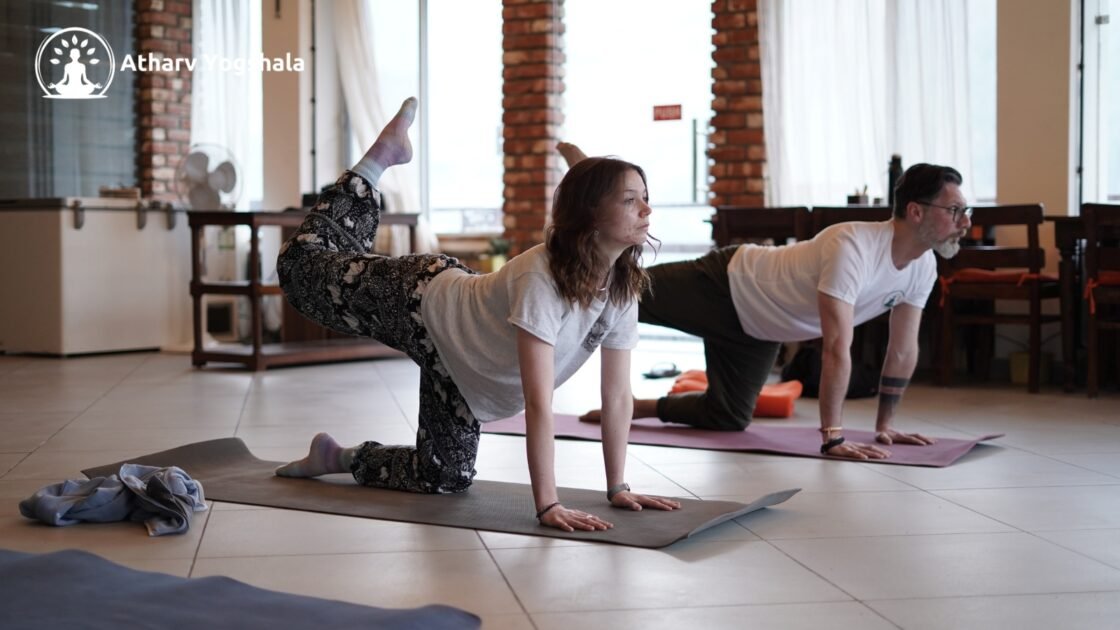
In recent years, the popularity of yoga, particularly the physical practice of asanas (poses), has soared. Many practitioners find solace, strength, and flexibility through their practice.
However, like any physical activity, asana practice carries the risk of injury if not approached mindfully. In this article, we explore the nuances of asana practice and how to prevent injuries along the yogic journey.
Understanding the Risks:
Asanas are powerful tools for physical and mental well-being, but they can also strain muscles, joints, and connective tissues if not practiced with care.
Common yoga injuries include strains, sprains, and overuse injuries, particularly in areas like the shoulders, wrists, knees, and lower back. These injuries often arise from overexertion, improper alignment, or pushing beyond one’s physical limits.
Furthermore, the repetitive nature of some asanas, such as sun salutations or vinyasa flows, can exacerbate existing imbalances or weaknesses if not balanced with counterposes or complementary movements. It’s essential to recognize that while yoga can promote healing and resilience in the body, it is not immune to the risk of injury.
The Role of Alignment:
Alignment is the cornerstone of a safe and effective yoga practice. Proper alignment not only maximizes the benefits of each pose but also reduces the risk of injury. Alignment principles vary depending on the style of yoga practiced, but they generally emphasize stability, balance, and integrity in each posture.
For example, in standing poses like Warrior I (Virabhadrasana I), alignment cues might include aligning the front knee over the ankle, squaring the hips toward the front of the mat, and lengthening the spine.
In arm balances like Crow Pose (Bakasana), engaging the core, stacking the joints, and distributing weight evenly are crucial for stability and injury prevention.
It’s important to pay attention to alignment cues from experienced teachers and to cultivate body awareness to recognize when your alignment may be compromised. Props such as blocks, straps, and blankets can also be valuable tools for supporting proper alignment and preventing strain or injury.
The Importance of Mindfulness:
Mindfulness is at the heart of yoga practice. Being present and attentive to your body’s sensations, limitations, and boundaries is crucial for injury prevention. This means honoring your body’s needs, practicing non-judgmental awareness, and cultivating patience and compassion toward yourself.
Mindful movement involves moving with intention and awareness, rather than mechanically going through the motions. By tuning into the subtle feedback from your body, you can adjust your practice accordingly to avoid pushing too hard or ignoring warning signs of discomfort.
Building Strength and Flexibility Safely:
One of the beauties of yoga is its ability to simultaneously build strength and flexibility. However, progress should be gradual and balanced. Rushing into advanced poses without proper preparation or attempting to force your body into positions it’s not ready for can result in injury.
Instead, focus on building a strong foundation through foundational poses and functional movements that target key muscle groups.
Incorporating strength-building exercises such as plank variations, lunges, and squats can help prepare the body for more challenging poses. Similarly, gentle and consistent stretching can gradually increase flexibility without risking strain or injury.
Listening to Your Body:
Your body is your greatest teacher in yoga. Learning to listen to its signals is essential for injury prevention. Pain is your body’s way of communicating that something is wrong, so it’s important not to ignore it. Distinguishing between discomfort that arises from stretching and pain that indicates potential injury is crucial.
If a pose doesn’t feel right, honor your body’s wisdom by modifying or skipping it altogether. Remember that yoga is not about achieving perfection in poses but about cultivating a deeper connection with yourself and your body’s innate intelligence.
Incorporating Rest and Recovery:
Rest and recovery are as important as the active practice itself. Giving your body time to recuperate allows muscles to repair and strengthen, reducing the risk of overuse injuries. Incorporate rest days into your practice schedule, and explore complementary practices like restorative yoga, meditation, or gentle stretching to support your body’s healing process.
Additionally, self-care practices such as massage, foam rolling, and epsom salt baths can help alleviate muscle soreness and promote relaxation. By prioritizing rest and recovery, you can sustain a lifelong yoga practice that nourishes both body and mind.
Conclusion:
Asana practice can be a transformative journey for both body and mind, but it’s essential to approach it with mindfulness, awareness, and respect for your body’s limitations. By prioritizing proper alignment, listening to your body, and cultivating a balanced practice that includes both challenge and rest, you can reap the benefits of yoga while minimizing the risk of injury.
Remember, the true essence of yoga lies not in achieving perfect poses, but in the journey of self-discovery and self-care that unfolds with each breath and each movement. May your practice be a source of joy, healing, and empowerment as you navigate the path of yoga with grace and wisdom.












Leave a comment: